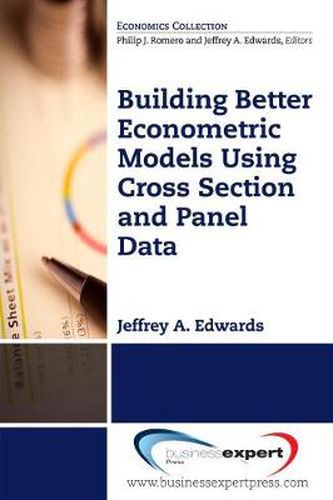Readings Newsletter
Become a Readings Member to make your shopping experience even easier.
Sign in or sign up for free!
You’re not far away from qualifying for FREE standard shipping within Australia
You’ve qualified for FREE standard shipping within Australia
The cart is loading…






This title is printed to order. This book may have been self-published. If so, we cannot guarantee the quality of the content. In the main most books will have gone through the editing process however some may not. We therefore suggest that you be aware of this before ordering this book. If in doubt check either the author or publisher’s details as we are unable to accept any returns unless they are faulty. Please contact us if you have any questions.
Many empirical researchers yearn for an econometric model that better explains their data. Yet these researchers rarely pursue this objective for fear of the statistical complexities involved in specifying that model. This book is intended to alleviate those anxieties by providing a practical methodology that anyone familiar with regression analysis can employ-a methodology that will yield a model that is both more informative and is a better representation of the data. This book outlines simple, practical procedures that can be used to specify a model that better explains the data. Such procedures employ the use of purely statistical techniques performed upon a publicly available data set, which allows readers to follow along at every stage of the procedure. Using the econometric software Stata (though most other statistical software packages can be used as well), this book demonstrates how to test for model misspecification and how to respecify these models in a practical way that not only enhances the inference drawn from the results, but adds a level of robustness that can increase the researcher’s confidence in the output generated. By following this procedure, researchers will be led to a better, more finely tuned empirical model that yields better results.
$9.00 standard shipping within Australia
FREE standard shipping within Australia for orders over $100.00
Express & International shipping calculated at checkout
This title is printed to order. This book may have been self-published. If so, we cannot guarantee the quality of the content. In the main most books will have gone through the editing process however some may not. We therefore suggest that you be aware of this before ordering this book. If in doubt check either the author or publisher’s details as we are unable to accept any returns unless they are faulty. Please contact us if you have any questions.
Many empirical researchers yearn for an econometric model that better explains their data. Yet these researchers rarely pursue this objective for fear of the statistical complexities involved in specifying that model. This book is intended to alleviate those anxieties by providing a practical methodology that anyone familiar with regression analysis can employ-a methodology that will yield a model that is both more informative and is a better representation of the data. This book outlines simple, practical procedures that can be used to specify a model that better explains the data. Such procedures employ the use of purely statistical techniques performed upon a publicly available data set, which allows readers to follow along at every stage of the procedure. Using the econometric software Stata (though most other statistical software packages can be used as well), this book demonstrates how to test for model misspecification and how to respecify these models in a practical way that not only enhances the inference drawn from the results, but adds a level of robustness that can increase the researcher’s confidence in the output generated. By following this procedure, researchers will be led to a better, more finely tuned empirical model that yields better results.